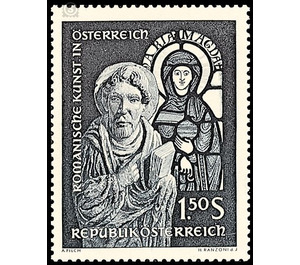art - Austria / II. Republic of Austria 1964 - 1.50 Shilling
Theme: Art & Culture
| Country | Austria / II. Republic of Austria |
| Issue Date | 1964 |
| Face Value | 1.50 |
| Color | black |
| Printing Type | Typography |
| Stamp Type | Commemorative |
| Item Type | Stamp |
| Chronological Issue Number | 494 |
| Chronological Chapter | OOS-OE2 |
| Michel ID | OOS 1151 |
| SID | 981798 |
| In 69 Wishlists | |
Generally, the period from 1050 to 1250 in the art is called Romanesque. The area of today's Austria fell in this epoch under the sovereignty of various noble families. The Babenbergs administered the territory of Lower Austria and parts of Upper Austria, in Styria ruled the family of Ottokare, the Duchy of Carinthia was governed by the Eppensteinern, Salzburg was under the sovereignty of the Church as archbishopric, and Tyrol got its name from the ruling Grafengeschlecht. Austria experienced its first upswing at this time, the ruling houses - church and nobility - were influential and shaped as a generous patrons of culture. Thus, Vienna was a center of courtly poetry among the Babenbergers, in which the most famous German minnesinger and poet Walther von der Vogelweide learned to sing and to say. The Nibelungenlied was also created in this art-friendly environment. However, Romanesque art is most clearly and impressively observed in ecclesiastical architecture, for example at the collegiate church of Klosterneuburg or at the cathedral in Gurk. Subordinate to her were sculpture, wall painting and stained glass. The Magdalene Disc from Weitensfeld, one of the few surviving works of stained glass, forms the template for this stamp together with the Apostle bust from the Giant Gate to St. Stephen in Vienna.
| Condition | Name | In Stock | Price | Price + Shipping | Store | |
|---|---|---|---|---|---|---|
 | Unmounted Mint ** | art - Austria / II. Republic of Austria 1964 - 1.50 Shilling | 1 | US $107.71 | N/A |  Utestamps (0) Utestamps (0)Request a Shipping Quote Minimum Lot Average US $1.95 |


